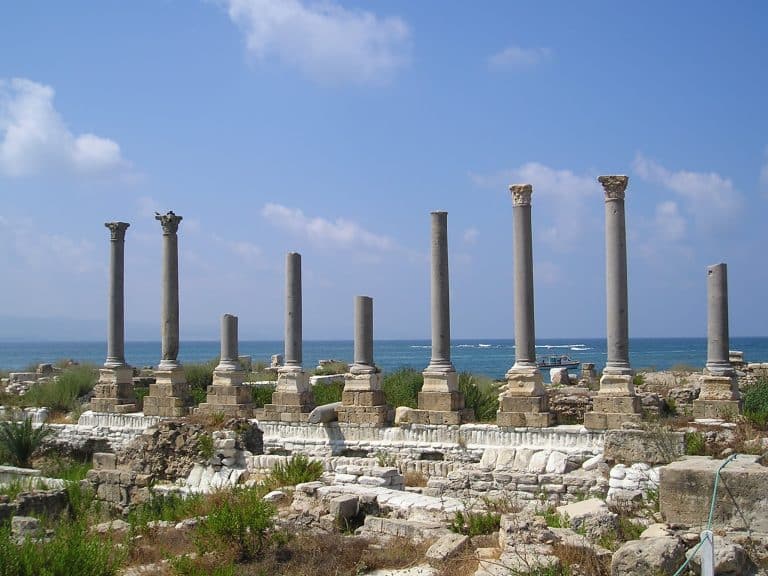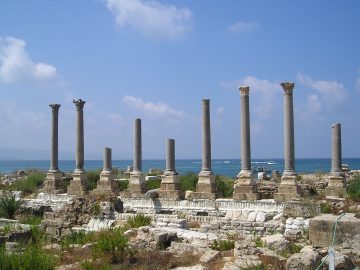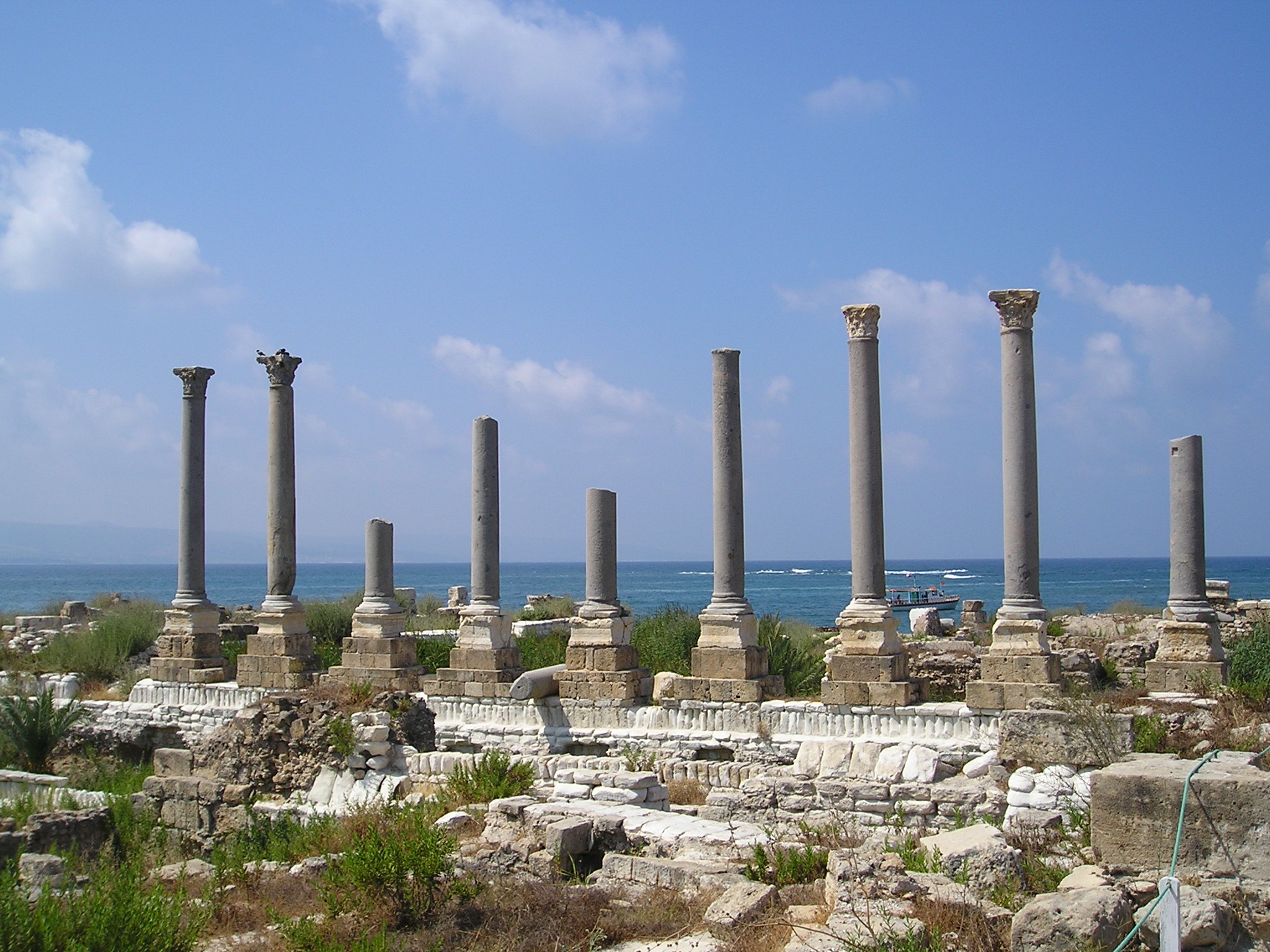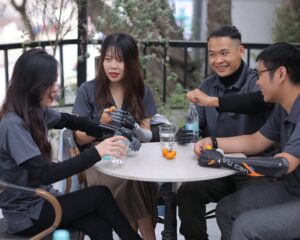[Photo credit: “Tyre Al Mina” by Heretiq, Wikipedia Commons]
By Kaylee
I’ve been studying the bible story of the Syrophoenician woman. In the King James Version she’s called the Syrophenician woman. Matthew calls her “a woman of Canaan.” But if you know the story, you probably remember it as the one where Jesus calls the woman a dog.
It’s found in Matthew 15:21-28 and Mark 7:24-30 and it goes like this:
Jesus has been preaching in Galilee and has been getting mobbed by the people after John the Baptist’s death. Pharisees come up from Jerusalem to see what’s going on, and they get into a heated debate with Jesus over washing hands before eating. (Yes, really.) So Jesus decides to take a beach vacation to the Gentile city of Tyre. Somehow this Gentile woman of another ethnicity (Matthew calling her a Canaanite—even though that term was archaic by New Testament times—was a shorthand way to say she is “other”) finds Jesus and asks him to cast a devil out of her daughter. She calls him “Lord” and “Son of David.” Jesus straight up ignores her. Her cries must have been pretty obnoxious because Jesus’ disciples ask him to send her away. Jesus replies to them, “I was sent only to the lost sheep of the house of Israel.” Nevertheless, she persisted. She knelt before him and asked for help. He replied, “It is not fair to take the children’s food and throw it to the dogs.” Her response: “Yes, Lord, yet even the dogs eat the crumbs that fall from their masters’ table.” Because of her strong argument and great faith, her daughter was instantly healed.
This is a kinda quirky story, and one we hardly ever talk about at church.*
To work through this story, I made two lists.
Parts that challenge me:
- Jesus ignores her.
- As the God of the Old Testament, Jesus supposedly commanded the extermination of her ancestors.
- Disciples tell Jesus to send her away.
- Jesus is unwilling to help her because she isn’t an Israelite.
- Jesus calls her a dog.
- Jesus was nice to the woman at the well (a Samaritan). Why isn’t he nice here?
Parts I like:
- The woman is faithful.
- The woman is persistent.
- The woman is quick witted.
- The woman is humble.
- The woman is focused on her end goal: getting help for her daughter. She doesn’t allow offensive behavior or words to derail her from this goal.
- The woman gives Jesus a strong argument to heal her daughter, and the daughter is healed.
- The woman is an example of “love your enemies, bless them that curse you.”
The reason this story really resonates with me is the amazing example of this woman. She owned her desire for a blessing. She was determined. She was not cowed by the voice of authority telling her no. She advocated for her daughter. And she did all this while still being incredibly humble. I particularly love how she cleverly retold and expanded Jesus’ parable of the dogs and the children: she used the retelling to give herself a seat at the table (even if it was under the table, with the expectation of scraps.) The way she shifted the perspective of the story provided a strong argument for healing her daughter.
On the other hand, this is a challenging scripture story because Jesus seems to show up on the “wrong” list. The answer to the question, “What would Jesus do?” generally does not include ignoring or belittling people. It can be hard to make sense of stories with scant details that happened in an ancient culture that you are reading about through translation. There are all sorts of explanations of Jesus’ behavior. Maybe he was testing her faith. Maybe he was testing his disciples to see if they thought he should break the mission rules and minister to someone who was not of “the lost sheep of the house of Israel” (compare Matt 10:5-6 to Matt 15:24). Maybe he was trying to clarify the point that he was trying to make to the Pharisees: “it is not what goes into the mouth that defiles a person, but it is what comes out of the mouth that defiles” (Matt 15:11). Jesus was putting bad words and actions into the Syrophoenician woman and only getting good words and actions out of her, proving her pure heart. Or, maybe the human side of Jesus was still learning grace to grace. Twelve-year-old Jesus hadn’t learned about telling his mom where he’s going, what he’s doing, who he’ll be with, and what time he’ll be back. Perhaps thirty-something-year-old Jesus had yet to comprehend the full extent of his ministry. Perhaps he was still learning to see his own prejudice. I don’t know. Initially, the premise that Jesus could have been prejudiced made me uncomfortable, but choosing to frame the story with this premise has helped me understand it in new ways.
It is easy for me to identify with the Syrophoenician woman and see her as an example of how to advocate for changes in the church that would be a blessing to myself and my daughters. It challenges my heart to accept as necessary the hefty amount of humility she displayed. It is not as easy for me to identify with Jesus in this story. There are so many questions I have about the motivations behind his actions. At some point though, I realized that that if I want something in the church structure to change, I have to ask people who are willing to follow Jesus’ example in this story. That surprised me, because, well, didn’t Jesus show up on the “wrong” list here?
How did he get put into the “follow His example” category? If we assume that Jesus was prejudiced against the woman, but was then willing to listen to her and change how he acted towards her, he shows personal growth and learning. I hesitate to call what Jesus did “repentance,” because that implies that there was sin. I wonder, though, if we suppose that Jesus was ignorant of his prejudice against this woman until this moment, can it be counted as sin? This actually gives me a good deal of hope, because I am still learning. I am still finding many parts of my mind that are ignorant and uninformed (not for lack of trying, but still). And I hope I can change course as thoroughly and gracefully as Jesus did. Framing the story as one in which Jesus experiences growth humanizes him so that I can actually try to follow his example. This story then becomes a wonderful model of “when I know better, I do better.” Jesus didn’t just “do better” in this story, he continued to “do better” afterward.
Before Jesus came to Tyre, he fed the five thousand. There were twelve baskets of food left over. Biblical numerology says that the number five represents divine grace and the number twelve represents God’s governing power. So these numbers represent feeding the Jews, who were chosen of God, and what is left over is the priesthood. The story of the Syrophoenician woman happens right in between two nearly-identical stories of feeding the multitudes. I like to think that the Syrophoenician woman’s argument didn’t just heal her daughter, but also changed Jesus’ course as he continued in his ministry.
After Jesus left Tyre, he preached throughout many Gentile regions. He came back to the Sea of Galilee and fed a multitude of four thousand. This time seven baskets of food were left over. The number four implies geographic fullness or universal truth. It seems likely that Gentiles were in this crowd. The number seven implies completion or perfection. I love the expansion of God’s nurturing represented by these numbers. I love that when everyone is fed, the result is not just priesthood, but perfection. This is a beautiful message of inclusiveness. And not a message I was expecting to find when I first glanced through this story.
*I’m a life-long member and I don’t specifically recall ever discussing this story at church. Maybe we talked about it in Seminary, but that could be hopeful thinking on my part. The Come Follow Me curriculum for this year never mentions this story.
Kaylee only wears sensible shoes (if she has to wear shoes at all) and is passionate about pants with functional pockets (even her Sunday slacks).







7 Responses
Thank you for sharing this. This story has always made me uncomfortable because of the way Jesus reacted in it. I appreciate your efforts to meditate on it and look below the surface.
What a wonderful interpretation! I know that I’ve read this story before, but I’ve never really thought about it. Thanks for your insights from numerology, which I’m not familiar with.
I love how you have thought through this more difficult scripture story. Great insights. (Also your post inspired me to look up that handwashing incident, and as a public health professional, I have to side with the Pharisees on that one.)
Thanks for writing about one of my favorite stories in the NT! The woman is my hero! She is humble but doesn’t take “no” for an answer, especially from a man, especially from someone who is being touted as the Son of God, the Messaih. When I get to the other side I hope to ask Jesus for His side of the story, Did he REALLY behave in such a boorish way? Irregardless of that, this mother is serious in pursuing a blessing for her daughter. She is willing to do the difficult work as an outsider-with all that that loaded term means both as a woman and a Canaanite, to help her daughter be healed. Frankly, there are few, if any better examples of deep and abiding faith overcoming all sorts of obstacles in our scriptures. While this woman is unnamed she should be held up as an example of all that we women (as well as girls and young women) should aspire to be as women of faith.
Thank you for linking to this story, and for writing it. Somehow this story soothes me as I grapple with current issues. I think this woman just might be my hero too.
I just found an amazing speech about this story by Dr. Fatimah Sallah from Sunstone’s Theology From the Margins conference. Worth a listen.
https://sunstonemagazine.com/2015-theology-from-the-margins-conference-keynote-speech-by-fatimah-salleh/?fbclid=IwAR3rG-nTDTHKYf2gB57gQtPZkaqTrbJbZd6AY1T9r7ky6GULyobwaBs2WcY
I love how the girl was healed because of her mother’s faith. Not because Jesus healed her.